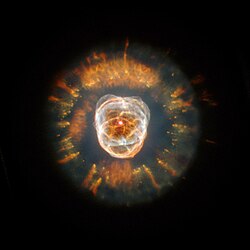| Emission nebula | |
|---|---|
| Planetary nebula | |
 NGC 2392, the Eskimo Nebula by HST in 1999. | |
| Observation data: J2000 epoch | |
| Right ascension | 07h 29m 10.7669s [1] |
| Declination | +20° 54′ 42.488″ [1] |
| Distance | 6520±560 [2] ly |
| Apparent magnitude (V) | 10.1 [1] |
| Apparent dimensions (V) | 48″; × 48″; [3] |
| Constellation | Gemini |
| Physical characteristics | |
| Radius | ≥0.34 ly [a] ly |
| Absolute magnitude (V) | ≤0.4 [b] |
| Notable features | – |
| Designations | NGC 2392, [1] Caldwell 39, PN G197.8+17.3 Central Star: HIP 36369, HD 59088, TYC 1372-1287-1 |
The Eskimo Nebula (NGC 2392), also known as the Clown Face Nebula, Lion Nebula, [4] or Caldwell 39, is a bipolar [5] double-shell [6] planetary nebula (PN). It was discovered by astronomer William Herschel in 1787. The formation resembles a person's head surrounded by a parka hood. It is surrounded by gas that composed the outer layers of a Sun-like star. The visible inner filaments are ejected by a strong wind of particles from the central star. The outer disk contains unusual, light-year-long filaments.
Contents
NGC 2392 lies about 6500 light-years away, and is visible with a small telescope in the constellation of Gemini.
At the center of NGC 2392, there is an O-type star (designated HD 59088 [7] ) with a spectral type of O(H)6f. [8]
